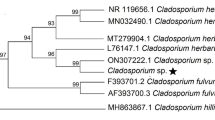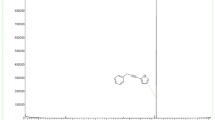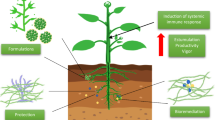Abstract
Direct and residual toxicities of seed extracts and leaf powders of the neem tree (Azadirachta indica), marigold (Tagetes erecta) and durba (Cynodon dactylon) along with two commercial insecticides (malathion and carbaryl, respectively) towards the red flour beetle (Tribolium castaneum), a major stored-product pest, were evaluated. All seed extracts and leaf powders showed a certain degree of toxicity towards the insects. Among the tested plant derivatives, neem seed extract (100 μg/insect) showed higher direct toxicity (53.13 % mortality) towards red flour beetles than marigold (46.88 %) and durba (37 %) seed extracts. On the other hand, marigold leaf powder (5 %) showed a higher residual toxicity (57.09 % inhibition ratio) than neem (50.06 %) and durba (43.28 %) leaf powder. Compared with the commercial insecticides (malathion and carbaryl), neem seed extract and marigold leaf powder possess a potential as natural alternative insecticides towards the red flour beetle in stored products.
Zusammenfassung
Die direkte und residuale Giftwirkung von Samenextrakten und Blattpulvern von Azadirachta indica (Neembaum), Tagetes erecta (Aufrechte Sammetblume oder Studentenblume) und Cynodon dactylon (Hundszahngras) sowie den beiden Insektiziden Carbaryl und Malathion auf den Rotbraunen Reismehlkäfer (Tribolium castaneum), einen bedeutenden Vorratsschädling, wurde untersucht. Alle untersuchten Samenextrakte und Blattpulver zeigten eine gewisse Toxizität gegenüber den Insekten. Samenextrakte des Neembaums (100 μMg/Insekt) wiesen mit einer Mortalität von 53,13 % eine höhere direkte Toxizität auf als solche der Studentenblume (46,88 %) und des Hundszahngrases (37 %). Blattpulver (5 %) der Studentenblume hingegen zeigten eine höhere residuale Toxizität (57,09 %) als solche von Neem (50,06 %) und Hundszahngras (43,28 %). Der Samenextrakt des Neembaums und Studentenblumen-Blattpulver besitzen im Wirkungsvergleich mit den Insektiziden Carbaryl und Malathion ein Potenzial als alternative Insektizide gegen den Rotbraunen Reismehlkäfer im Nacherntebereich.
Similar content being viewed by others
Literature
Abbott, W. S. (1925): A method of computing the effectiveness of an insecticide. J. Econ. Entomol. 18, 265–267.
Anonymous (1991): Recommendations of the symposium on resources for sustainable agriculture: The use of neem and other plant materials for pest control and rural development. Proceedings, 17th Pacific Science Congress, 1–11.
Arther, F. H., Zettler, J. L. (1991): Malathion resistance in Tribolium castaneum: Difference between mortality caused by topical surfaces. J. Econ. Entomol. 84, 721–729.
Bomford, M. K., Isman, M. B. (1996): Desensitization of fifth instar Spodoptera litura to azadirachtin and neem. Ent. Exp. Appl. 81, 307–313.
Chan, L. S. (1992): Towards integrated pest management of rice in Korea. Kor. J. Appl. Entomol. 31, 205–240.
Collins, P. J. (1998): Inheritance of resistance to pyrethroid insecticides in Tribolium castaneum (Herbst). J. Stored-Prod. Res. 34, 395–401.
Dhaliwal, B. K., Chawla, R. P. (1995): Evaluation of current status of malathion resistance in Tribolium castaneum (Herbst) (Coleoptera: Tenebrionidae) in Punjab, India. J. Pestic. Res. 7, 54–57.
Duncan, D. B. (1951): A significance test for differences between ranked treatments in an analysis of variance. Virginia J. Sci. 2, 171–189.
Ewete, F. K., Arnason, J. T., Larson, J., Philogene, B. J. R. (1996): Biological activities of extracts from traditionally used Nigerian plants against the European corn borer, Ostrinia nubilalis. Ent. Exp. Appl. 80, 531–537.
Finney, D. J. (1971): Statistical Method in Biological Assay, 2nd edition. Griffin, London.
Halliday, W. R., Arthur, F. H., Zettler, F. H. (1988): Resistance status of red flour beetle (Coleoptera: Tenebrionidae) infesting stored peanuts in Southeastern United States. J. Econ. Entomol. 81, 74–77.
Haubruge, E., Arnaud, L., Mignon, J. (1997): The impact of sperm precedence in malathion resistance transmission in populations of the red flour beetle Tribolium castaneum (Herbst) (tiColeoptera: Tenebrionidae). J. Stored-Prod. Res. 33, 143–146.
Haubruge, E., Arnaud, L. (2001): Fitness consequences of malathion-specific resistance in red flour beetle (Coleoptera: Tenebrionidae) and selection for resistance in the absence of malathion. J. Econ. Entomol. 94, 552–557.
Hermawan, W., Nakajima, S., Tsukuda, R., Fujisaki, K., Nakasuji, F. (1997): Isolation of an antifeedant compound from Andrographis paniculata (Acanthaceae) against the diamondback moth, Plutella xylostella (Lepidoptera: Yponomeutidae). Appl. Entomol. Zool. 32, 551–559.
Irshad M., Gillani, W. A. (1990): Resistance in Tribolium castaneum (Herbst) (Coleoptera: Tene-brionidae) against malathion. Pakistan J. Zool. 22, 257–262.
Khanam, L. A. M., Talukder, D. (1993): Effect of Bishkatali, Polygonum hydropiper L., leaf and Royna, Aphanamixis polystachya Wall. (Parker) seed coat extract on the fecundity and fertility of Tribolium confusum. Bangladesh J. Sci. Ind. Res. 27, 49–55.
Kotze, A. C., Wallbank, B. E. (1996): Esterase and monooxygenase activities in organophosphate-resistant strains of Oryzaephilus surinamensis (Coleoptera: Cucujidae). J. Econ. Entomol. 89, 571–576.
Malek, M. A., Wilkins, R. M. (1995): Effects of Annona squamosa L. seed oil on the larvae of Tribolium castaneum (Herbst) (Coleoptera: Tenebrionidae). Bangladesh J. Zool. 23, 65–70.
Mohiuddin, S., Qureshi, R. A., Ahmed, Z., Qureshi, S. A., Jamil, K., Jyothi, K. N., Prasuna, A. L. (1993): Laboratory evaluation of some vegetable oils as protectants of stored products. Pakistan J. Sci. Ind. Res. 36, 377–379.
Mordue, A. J., Blackwell, A. (1993): Azadirachtin: An update. J. Insect Physiol. 39, 903–924.
Mukhopadhyay, S. K., Buddhadeb, D., Duary, B., Dasgupta, M. K., Ghosh, D. C., Gupta, D. D., Majumdar, D. K., Chattopadhyay, G. N., Ganguli, P. K., Munsi, P. S., Bhattacharya, D. (1995): Ethnobotany of some common crop field weeds in a sub-humid agricultural tract of West Bengal. Proceedings, National Symposium on Sustainable Agriculture in Sub-humid Zone, West Bengal, India, 272–277.
Osman, N., Regesus, B. N. (1981): Evaluation of Indonesian strains of Tribolium castaneum (Herbst) for resistance to malathion and pirimiphos methyl. Philippine Entomol. 5, 405–414.
Pasalu I. C., Bhatia, S. K. (1983): Inheritance of resistance to malathion in Tribolium castaneum (Herbst). Proc. Indian Acad. Sci. Anim. Sci.) 92, 409–414.
Pascual, V. M. J., Robledo, A. (1998): Screening for anti-insect activity in Mediterranean plants. Ind. Crops Prod. 8, 183–194.
Saxena, R. C., Dixit, O. P., Sukumaran, P. (1992): Laboratory assessment of indigenous plant extracts for anti-juvenile hormone activity in Culex quinquefasciatus. Indian J. Med. Res. Sect. A Infec. Dis. 95, 204–206.
Saxena, J. D., Sinha, S. R. (1995): Cross resistance spectrum of a laboratory selected deltamethrin— resistant strain of red flour beetle, Tribolium castaneum (Herbst). Indian J. Entomol. 57, 116–119.
Sharma, R. K. (1999): Efficacy of neem products against storage pests in maize. Ann. Agric. Res. 20, 198–201.
Stuart, J. J., Ray, S., Harrington, B. J., Neal, J. J., Beeman, R. W. (1998): Genetic mapping of a major locus controlling pyrethroid resistance in Tribolium castaneum (Coleoptera: Tenebrionidae). J. Econ. Entomol. 91, 1232–1238.
Talukder, F. A., Howse, P. E. (1993): Deterrent and insecticidal effects of extracts of pithraj, Aphanamixis polystachya (Meliaceae) against Tribolium castaneum, in storage. J. Chem. Ecol. 19, 2463–2471.
Talukder, F. A., Howse, P. E. (1995): Evaluation of Aphanamixis polystachya as repellants, antifeedants, toxicants and protectants in storage against Tribolium castaneum (Herbst). J. Stored-Prod. Res. 31, 55–61.
Talukder, F. A, Miyata, T. (2002): In vivo and in vitro toxicities of pithraj and neem against rice green leafhopper (Nephotettix cincticeps Uhler). Z. Pflanzenkrankh. Pflanzensch. — J. Plant Dis. Protect. 109, 543–550.
Werner, P. (1997): Insecticide resistance in red flour beetle, Tribolium castaneum (Coleoptera: Tenebrionidae) in the Czech Republic. Ochrana Rostlin 33, 57–63.
Xie, Y. S., Fields, P. G., Isman, M. B. (1995): Repellency and toxicity of azadirachtin and neem concentrates to three stored-product beetles. J. Econ. Entomol. 88, 1024–1031.
Zettler, J. L (1991): Pesticide resistance in Tribolium castaneum and Tribolium confusum (Coleoptera: Tenebrionidae) from flour mills in the USA. J. Econ. Entomol. 84, 763–767.
Zettler, J. L., Arthur, F. H. (1997): Dose-response tests on red flour beetle and confused flour beetle (Coleoptera: Tenebrionidae) collected from flour mills in the United States. J. Econ. Entomol. 90, 1157–1162.
Author information
Authors and Affiliations
Corresponding author
Rights and permissions
About this article
Cite this article
Islam, M.S., Talukder, F.A. Toxic and residual effects of Azadirachta indica, Tagetes erecta and Cynodon dactylon seed extracts and leaf powders towards Tribolium castaneum. J Plant Dis Prot 112, 594–601 (2005). https://doi.org/10.1007/BF03356157
Received:
Accepted:
Published:
Issue Date:
DOI: https://doi.org/10.1007/BF03356157
Key words
- carbaryl
- direct and residual toxicity
- durba
- insecticides
- leaf powders
- malathion
- marigold
- neem
- seed extracts
- stored-product pests
- Tribolium castaneum




